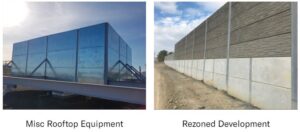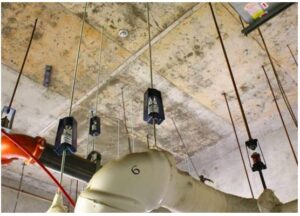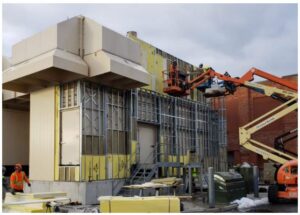parklane mechanical
Parklane Mechanical Acoustics
What he did have was expertise and ambition. Greg understood that while legislation requires organizations to manage complex industrial and commercial noise issues, few business leaders knew where or how to begin. So, he set out to build a business focused on developing comprehensive, client-focused noise and vibration solutions. His goal: simplifying what can be a daunting process for most facility operators and project stakeholders.
- Acoustic Barriers and Screens
- Silencer Systems
- Acoustic Enclosures
- Acoustic Plenums and Louvered Penthouses
- Vibration Mitigation
- Retrofit for Compliance
Noise Control Solutions
- Acoustic Barriers and Screens
- Silencer Systems
- Acoustic Enclosures
- Acoustic Plenums and Louvered Penthouses
- Vibration Mitigation
- Retrofit for Compliance
Acoustic Barriers and Screens
Acoustic Barriers are the most widely used form of mechanical sound attenuation due to their ability to mitigate noise emissions from a multitude of sources in one given location. Parklane Acoustic Barriers come in a variety of configurations, each specifically engineered to accommodate site-specific acoustic criteria, structural configuration, and architectural appeal.
Due to their unique modular frame design, Parklane Acoustic Barriers can easily be converted to a standard architectural screen system.
Applications
- Rooftop Equipment
- Rooftop Condensing Unit
- Rooftop Chillers
- Natural Gas Compressor Station
- Mechanical Bay Room
- Rooftop VRF Units
- Rezoned Development

Silencer Systems
Silencers are designed to attenuate transmission of sound through heating, ventilation and air conditioning (HVAC) systems in both interior and exterior environments. Though acoustic performance is substantiated through ASTM laboratory testing procedures, silencers must seamlessly function as an integral part of the aerodynamic system they are attenuating.
PMA Silencer Systems are designed to address both the required acoustic performance and site specific integration challenges.
Applications
- Cooling Tower Intake
- Air Cooled Condensing Unit
- Dryer Exhaust Stack
- Generator Room Exhaust
- High Plume Dilution Fan
- Scrubber Exhaust Stack
- Rooftop Exhaust Units

Acoustic Enclosures
Among the most versatile noise control solutions, acoustic enclosures are implemented when complete system shielding is required to address site-specific noise level criteria. PMA Acoustic Enclosures are engineered to provide guaranteed sound levels, mitigating both total system sound power and structure-borne vibration transmission.
PMA Acoustic Enclosures can be fully customized to integrate to varying site and equipment arrangements, architectural facades and mechanical system operations.
Applications
- Centrifugal Exhaust Fan
- Diesel Generator Outdoor
- Automotive Part Press
- Positive Displacement Blower
- Garage Ventilation Well
- Sifting Machine
- Natural Gas Generator

Acoustic Plenums and Louvered Penthouses
Air handling plenums provide space for circulation of heated/conditioned air. They can also provide the dual-pronged benefit of maintenance accessibility between multiple elements in an HVAC system. In a noise control arrangement, acoustically lined plenums provide insertion loss through absorptive dissipation of sound travelling through the mixed air space.
Louvered penthouses act primarily as an open draft weather enclosure over various types of exterior fan arrangements. They can be acoustically retrofitted to provide levels of sound reduction from the enclosed fan arrangement.
PMA Acoustic Plenums and Louvered Penthouses are unique in their functional design, integration versatility and architectural flexibility.
Applications
- Rooftop Condensing Units
- Smoke Control Exhaust Fans
- Make-up Air System
- High Plume Dilution Fan
- Engine Room Intake

Vibration Mitigation
A common issue in high-rise buildings is high ambient noise levels in occupied spaces. Often this a result of structure-induced vibration, typically caused by mechanical equipment or riser systems that are rigidly connected to a building structure. As the induced vibration travels through floor slabs and shear walls, these excitable mediums begin to act as speakers, thereby creating vibration-induced noise.
Parklane provides a turnkey service in mitigating structure-borne vibration concerns through defined source identification, anti-vibration component selection and final system integration/calibration.
Process:
Parklane’s Vibration Mitigation Service is carried out in the following fundamental steps:
- Source identification: Parklane’s anti-vibration solutions process begins with a top-to-bottom source review by our vibration specialists. This review is done in conjunction with the acting consultant, referencing all vibratory readings taken at the receiver point and tracing them back to any rigidly mounted mechanical systems.
- Component Selection: Once all sources have been identified, field data is compiled and cross-referenced with all applicable-source operational data. Parklane than sources lab-tested, anti-vibration products from trusted suppliers.
- Engineered Design: Parklane’s engineering team completes detailed integration design, such as new structural support requirements, piping modification and equipment disconnect requirements.
- Execution: Parklane’s execution team then works closely with building owners/managers in the final implementation and calibration of the new anti-vibration solution.

Retrofit for Compliance
In today’s mechanical equipment industry, owners commonly request that OEMs provide add-on options that will reduce noise emissions from their various equipment offerings. To provide economies of scale, OEMs typically provide these low-noise offerings in the form of standardized noise control packages (i.e., standard silencers, acoustic enclosures, attenuators, etc.). Though cost-effective, challenges arise when these acoustic add-ons have been purchased without reference to site-specific noise reduction requirements.
In circumstances where this equipment has already been installed and levels of acoustic reduction are found to be inadequate, Parklane can provide remedial retrofit measures to bring the underperforming system into compliance.
Process
Parklane’s Retrofit-For-Compliance (RFC) Service is carried out in the following fundamental steps:
- Source Evaluation: Parklane’s RFC process begins with a review of the existing source mitigation currently installed. This review is done in conjunction with the acting Acoustical Consultant, referencing the in-situ sound level readings and cross-referencing them with OEM sound data.
- Output Parameter Review: Once the deficiencies in the existing noise control system have been evaluated and quantified, Parklane’s engineering team completes the necessary component selections required to yield compliance.
- PMA Retrofit Design: Once all the necessary components have been selected, Parklane’s engineering team begins completing the final retrofit design to the existing system.
- Execution: Parklane’s execution team works closely with project stakeholders in the final implementation of the new noise control system.
- Audit: To ensure performance has been achieved, post-installation sound measurements are completed by the client’s Acoustical Consultant.


